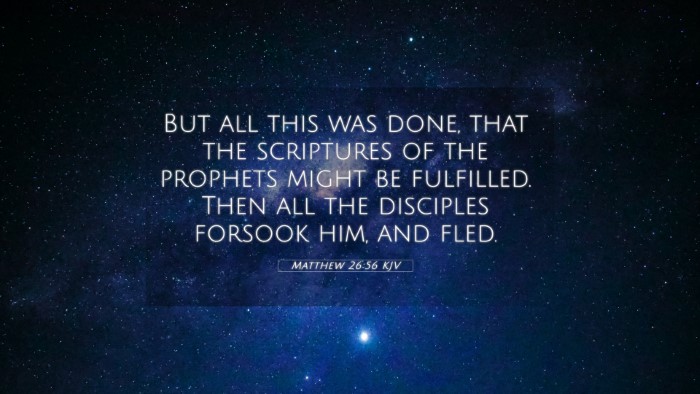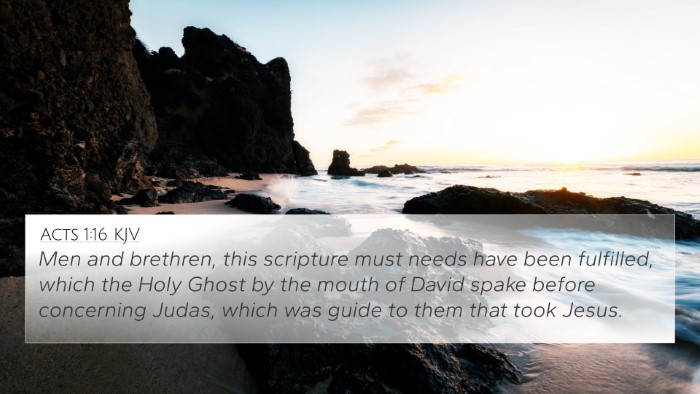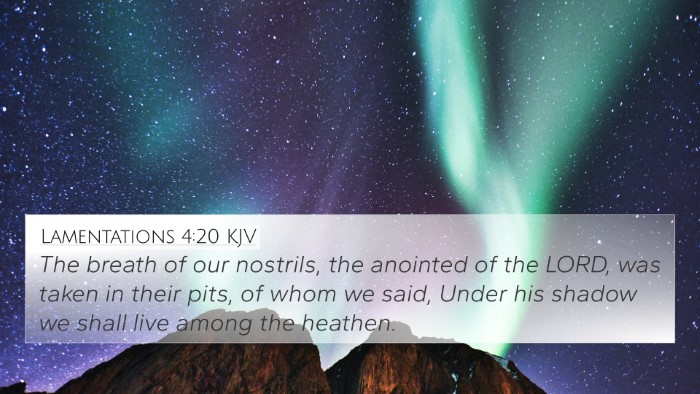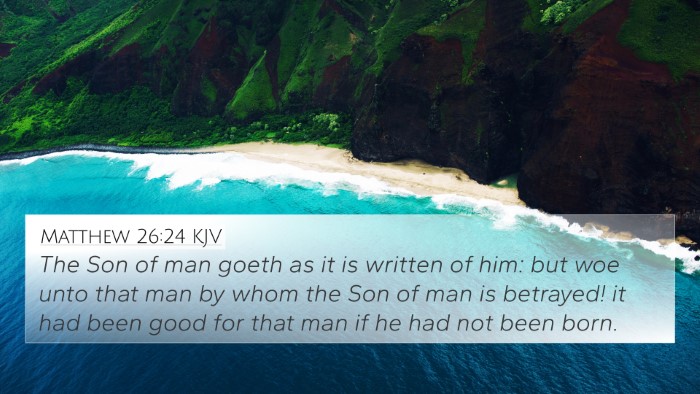Understanding Matthew 26:56
Bible Verse: Matthew 26:56 - "But all this was done, that the scriptures of the prophets might be fulfilled. Then all the disciples forsook him, and fled."
Summary of Meaning
This verse falls within the climactic moments of Jesus' arrest. It captures the abandonment of Jesus by His disciples, fulfilling prophetic scripture. The commentary from various biblical scholars brings several interpretations to light:
- Prophetic Fulfillment: Matthew Henry suggests that the fleeing of the disciples was necessary to fulfill the prophecies concerning the Messiah. This act highlights the frailty of human nature contrasted with the steadfastness of God's plan.
- Disciples' Weakness: Albert Barnes notes the irony of the disciples' fear and flight in the face of Christ's impending suffering. Their departure illustrates a momentary lapse of faith, emphasizing the human struggle against fear and persecution.
- Jesus' Role as the Messiah: Adam Clarke emphasizes that Jesus’ arrest was not a failure but a necessary part of the redemptive story, confirming that He came to fulfill the scriptures.
Connections Between Bible Verses
This verse can be cross-referenced with several significant passages that enhance the understanding of its meaning:
- Zechariah 13:7: "Awake, O sword, against My Shepherd, and against the man that is My fellow, saith the LORD of hosts: smite the shepherd, and the sheep shall be scattered..." This verse highlights the prophetic scattering of the disciples.
- Isaiah 53:3: "He is despised and rejected of men; a man of sorrows, and acquainted with grief..." This passage parallels the suffering and rejection faced by Jesus, which the disciples experienced indirectly.
- Mark 14:50: "And they all forsook him, and fled." This is a direct parallel showing the abandonment of Jesus by His followers in both Gospel accounts.
- Luke 22:54: "Then took they him, and led him, and brought him into the high priest's house. And Peter followed afar off." This emphasizes the fearful distance the disciples placed between themselves and Jesus during His trial.
- John 18:8: "Jesus answered, I have told you that I am he: if therefore ye seek me, let these go their way." This acknowledges the protective aspect of Jesus' intention to shield His followers even as He faced arrest.
- Psalms 31:11: "I was a reproach among all mine enemies, but especially among my neighbors, and a fear to my acquaintance: they that did see me without fled from me." This reflects the fear and abandonment that Jesus faced, illustrating the emotional aspect of his experience.
- Matthew 10:32-33: "Whosoever therefore shall confess me before men, him will I confess also before my Father which is in heaven. But whosoever shall deny me before men, him will I also deny before my Father which is in heaven." A profound teaching that correlates the consequences of public allegiance to Christ amidst fear.
Thematic Bible Verse Connections
The theme of abandonment amidst suffering is prevalent throughout the Bible. Notably, it showcases human frailty in the face of divine purpose:
- Fear and Courage: Many verses deal with the struggle between faith and fear, including 2 Timothy 1:7 which states, "For God hath not given us the spirit of fear; but of power, and of love, and of a sound mind."
- God’s Sovereignty: Proverbs 19:21 highlights that "There are many devices in a man's heart; nevertheless the counsel of the Lord, that shall stand," underscoring that God’s plans will prevail despite human actions.
- Repentance and Restoration: Following their flight, the disciples are ultimately restored, as seen in John 21, illustrating the importance of grace and forgiveness in the process of redemption.
Inter-Biblical Dialogue
Analyzing Matthew 26:56 provides an opportunity to explore the greater narrative arc in scripture regarding betrayal, fear, and God's redemptive design:
- Scripture invites readers to reflect on the relationship between prophecies in the Old Testament and their fulfillment in the New Testament, thus enhancing understanding of God's unyielding plan.
- Disciples' experiences serve as a reminder for contemporary believers on steadfastness in faith, even when challenges arise.
- Studying how Jesus’ predictions of betrayal connect with the Old Testament prophetic words can deepen one's understanding of the Bible as a unified narrative.
Conclusion
Matthew 26:56 provides rich thematic elements that invite deeper exploration through cross-referencing and comparative analysis. Emphasizing prophetic fulfillment, the frailty of human faith, and the overarching narrative of redemption reinforces the beauty and complexity of the Scriptures.
Tools for Bible Cross-Referencing
For those interested in studying cross-references, consider utilizing:
- Bible Concordances: Resources that provide thematic links and references to related scriptures.
- Bible Cross-Reference Guides: Structured tools that break down scripture connections by theme and context.
- Cross-Referencing Bible Study Methods: Techniques that involve analyzing Biblical texts in light of one another to enhance understanding.
By delving into the interconnectedness of scripture with Matthew 26:56 at the core, one can enhance their comprehension of the greater message of the Bible.


















